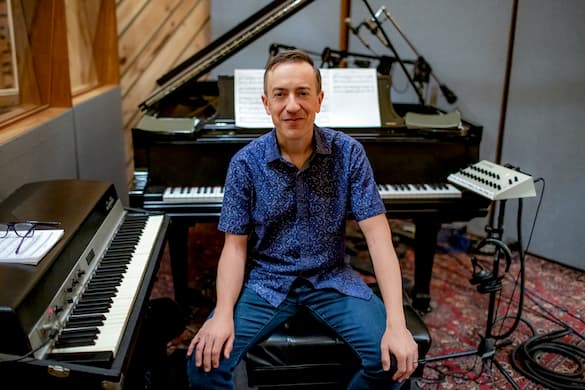Where Have All the Jazz Ensembles Gone?
Geoffrey Keezer may have titled his new release ‘Playdate’ because most jazz performances now are more about getting the musicians you want just to do a one-shot album or a gig.

Geoffrey Keezer
‘Playdate’ (Markeez Records)
Most of us first noticed Geoffrey Keezer with Art Blakey and the Jazz Messengers. Yet even before he played piano on the final three albums by that legendary band, Mr. Keezer had already recorded several CDs of his own — starting at a moment when he was all of 17. Now, at 51, he is among the youngest of contemporary jazzmen to have apprenticed with such giants of the bebop era as Blakey and Art Farmer.
Since then, Mr. Keezer has recorded a total of 23 albums as a leader and close to 100 sessions (at least in the standard Tom Lord jazz discography) as a sideman. On Wednesday, he launched his latest release with a one-night, two-show appearance at Dizzy’s Club, in Jazz at Lincoln Center.
Mr. Keezer came up in an era when regular working bands were the coin of the realm in this music. The economics of the last few decades and the pandemic of the last few years have combined to underscore that such full-time, steadily employed ensembles are increasingly rare. Most jazz performances now are more about getting the musicians you want just to do a one-shot album or a gig; perhaps that’s why Mr. Keezer has titled the new release “Playdate.”
At Dizzy’s, Mr. Keezer remarked about how difficult it was to reconvene the same colleagues from the album sessions even to do the record-launch show. Granted, this is a rather unusual ensemble: Looking at the musicians on the stage, it almost seemed like Mr. Keezer had assembled two distinct bands to somehow perform at the same time. First was a standard piano trio, with bassist Richie Goods and drummer Kendrick Scott. The other was a 1960s-style organ combo, with tenor saxophonist Ron Blake, guitarist Aayushi Karnik, Shedrick Mitchell playing Hammond B-3, and, again, Mr. Scott on drums.
There are other musicians on the album — not enough room on the small stage at Dizzy’s, alas — including an additional percussionist (Munyungo Jackson) and guitarist (Nir Felder). And, oh yes, there’s an 18-piece string orchestra on two tracks.
Mr. Keezer obviously intended this ambitious project as a vehicle for his considerable skills as a composer, and yet only half of the six tunes here are new originals: the opener, “Refuge,” “I. L. Y. B. D.,” and “M’s Bedtime Blues.” Of the others, “Her Look, Her Touch” and “Bebah” are by Mr. Mitchell, while “Tomorrow” is an optimistic funk tune by the Brothers Johnson from the 1976 debut album, “Look Out for #1.”
Just as the setup on stage looked like it could be two different bands — connected by a common drummer — the music performed moves in multiple directions. Some of these sounds could be described as third-stream, an archaic term meaning a hybrid, of sorts, between improvised jazz and formal classical music, and fusion, an also increasingly obsolete term describing the mashup of jazz and rock (and/or soul or funk).
As “Playdate” shows, these terms are anachronistic because such genres as jazz, classical, and pop are considerably more fluid these days. Mr. Keezer opened the set at Dizzy’s with a dramatic solo on “Refuge,” as if to assert that despite all the instruments on stage, this is still predominantly a piano project.
On the album, he gets straightaway into the strings. The use of the violins, here and on “Bebah,” also suggests yet another genre: movie music. Still, it’s the rare film score that includes full on jazz improvisation — as on “Refuge,” where the most salient feature is the big-toned tenor of Mr. Blake wailing over the string background. When Mr. Mitchell and then Ms. Karnik take the center stage immediately after, it feels like a moment in a movie when the director has crosscut to a different scene in the same story.
Some of the tunes, including the two by Mr. Mitchell and also Mr. Keezer’s “I. L. Y. B. D.” (which, the composer explained, is a quote from his wife, “I love you, but damn”), have more of a soul-jazz feel, but essentially no one tune on the album is just one thing. They all begin in one spot, end up in another, and travel off into all sorts of unforeseen areas along the way. Mr. Keezer also plays latinate clave patterns on several tunes, while “Bebah” has a flamenco-style opening that puts me in mind of “Concierto de Aranjuez.”
Mr. Mitchell’s other contribution, “Her Look, Her Touch,” is a romantic ballad. At Dizzy’s, he opened it with an extended organ intro that I described in my notes as “amazing.” Still, both live and on the album, the primary voice is Mr. Blake’s soft, crooning soprano saxophone.
“Bebah” makes the most of the two keyboards. Normally, the last thing a Hammond player needs is another keyboard instrument — even a bassist is largely superfluous — but Messrs. Keezer and Mitchell used the two big instruments as the foundation to support a formidable wall of sound. The opening set at Dizzy’s wasn’t long enough to include “M’s Bedtime Blues,” but on the album, this final selection combines multiple keyboards and diverse genres from stride piano to soul jazz to a little Monk-ishness.
The conjoined force of those two keyboards do more than support a lot of weight; between the two of them, they cover a lot of territory.

